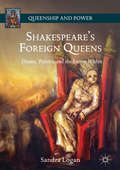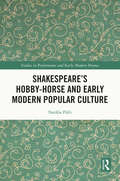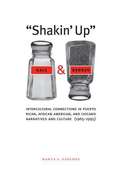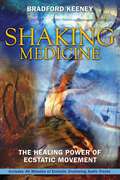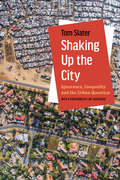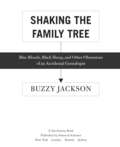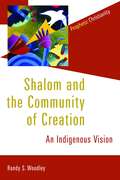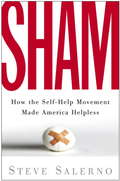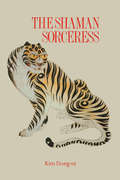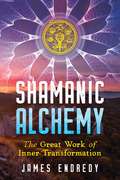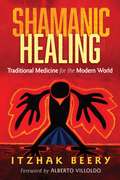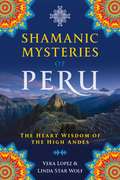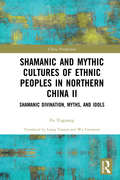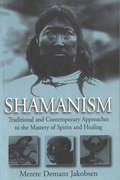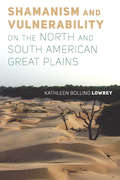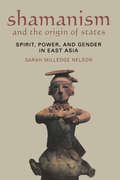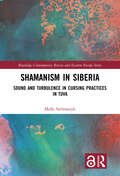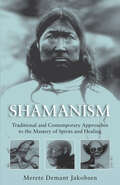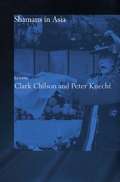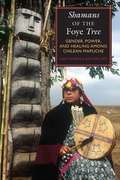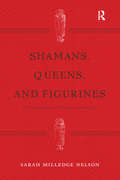- Table View
- List View
Shakespeare’s Foreign Queens: Drama, Politics, And The Enemy Within (Queenship and Power)
by Sandra LoganThis book examines Shakespeare’s depiction of foreign queens as he uses them to reveal and embody tensions within early modern English politics. Linking early modern and contemporary political theory and concerns through the concepts of fragmented identity, hospitality, citizenship, and banishment, Sandra Logan takes up a set of questions not widely addressed by scholars of early modern queenship. How does Shakespeare’s representation of these queens challenge the opposition between friend and enemy that ostensibly defines the context of the political? And how do these queens expose the abusive potential of the sovereign? Focusing on Katherine of Aragon in Henry VIII, Hermione in The Winter’s Tale, Tamora in Titus Andronicus, and Margaret in the first history tetralogy, Logan considers them as means for exploring conditions of vulnerability, alienation, and exclusion common to subjects of every social position, exposing the sovereign himself as the true enemy of the state.
Shakespeare’s Hobby-Horse and Early Modern Popular Culture (Studies in Performance and Early Modern Drama)
by Natália PikliThis book explores the ways in which the early modern hobby-horse featured in different productions of popular culture between the 1580s and 1630s. Natália Pikli approaches this study with a thorough and interdisciplinary examination of hobby-horse references, with commentary on the polysemous uses of the word, offers an informative background to reconsider well-known texts by Shakespeare and others, and provides an overview on the workings of cultural memory regarding popular culture in early modern England. The book will appeal to those with interest in early modern drama and theatre, dramaturgy, popular culture, cultural memory, and iconography.
Shakin' Up Race and Gender: Intercultural Connections in Puerto Rican, African American, and Chicano Narratives and Culture (1965-1995)
by Marta Ester SánchezThe second phase of the civil rights movement (1965-1973) was a pivotal period in the development of ethnic groups in the United States. In the years since then, new generations have asked new questions to cast light on this watershed era. No longer is it productive to consider only the differences between ethnic groups; we must also study them in relation to one another and to U.S. mainstream society.<P><P>In "Shakin' Up" Race and Gender, Marta E. Sánchez creates an intercultural frame to study the historical and cultural connections among Puerto Ricans, African Americans, and Chicanos/as since the 1960s. Her frame opens up the black/white binary that dominated the 1960s and 1970s. It reveals the hidden yet real ties that connected ethnics of color and "white" ethnics in a shared intercultural history. By using key literary works published during this time, Sánchez reassesses and refutes the unflattering portrayals of ethnics by three leading intellectuals (Octavio Paz, Daniel Patrick Moynihan, and Oscar Lewis) who wrote about Chicanos, African Americans, and Puerto Ricans. She links their implicit misogyny to the trope of La Malinche from Chicano culture and shows how specific characteristics of this trope--enslavement, alleged betrayal, and cultural negotiation--are also present in African American and Puerto Rican cultures. Sánchez employs the trope to restore the agency denied to these groups. Intercultural contact--encounters between peoples of distinct ethnic groups--is the theme of this book.
Shaking Medicine: The Healing Power of Ecstatic Movement
by Bradford KeeneyA revolutionary call to reawaken our bodies and minds to powerful healing through ecstatic movement • Shows how shaking medicine is one of the oldest healing modalities--practiced by Quakers, Shakers, Bushmen, Japanese, and others • Teaches readers how to shake for physical as well as spiritual therapeutic benefit Shaking Medicine reintroduces the oldest medicine on earth--the ecstatic shaking of the human body. Most people’s worst fear is losing control--of their circumstances, of their emotions, and especially of their bodies. Yet in order to achieve the transcendent state necessary to experience deep healing, we must surrender control. Examining cultural traditions from around the world where shaking has been used as a form of healing--from the Shakers and Quakers of New England to the shaking medicine of Japan, India, the Caribbean, the Kalahari, and the Indian Shakers of the Pacific Northwest--Bradford Keeney shows how shaking can bring forth profound therapeutic benefits. Keeney investigates the full spectrum of the healing cycle that occurs when moving from ecstatic arousal to deep trance relaxation. He explains how the alternating movement produced while shaking brings all the body’s energetic systems into balance. He includes practical exercises in how to shake for physical therapeutic benefit, and he shows how these techniques lead ultimately to the shaking medicine that both enables and enhances spiritual attunement.
Shaking Up the City: Ignorance, Inequality, and the Urban Question
by Tom SlaterShaking Up the City critically examines many of the concepts and categories within mainstream urban studies that serve dubious policy agendas. Through a combination of theory and empirical evidence, Tom Slater "shakes up" mainstream urban studies in a concise and pointed fashion by turning on its head much of the prevailing wisdom in the field. To this end, he explores the themes of data-driven innovation, urban resilience, gentrification, displacement and rent control, neighborhood effects, territorial stigmatization, and ethnoracial segregation. With important contributions to ongoing debates in sociology, geography, urban planning, and public policy, this book engages closely with struggles for land rights and housing justice to offer numerous insights for scholarship and political action to guard against the spread of an urbanism rooted in vested interest.
Shaking the Family Tree
by Buzzy Jackson"WHO ARE YOU AND WHERE DO YOU COME FROM? " As a historian, Buzzy Jackson thought she knew the answers to these simple questions--that is, until she took a look at her scrawny family tree. With a name like Jackson (the twentieth most common American surname), she knew she must have more relatives and more family history out there, somewhere. Her first visit to the Boulder Genealogy Society brought her more questions than answers . . . but it also gave her a tantalizing peek into the fascinating (and enormous) community of family-tree huggers and after-hours Alex Haleys. In Shaking the Family Tree, Jackson dives headfirst into her family gene pool: flying cross-country to locate an ancient family graveyard, embarking on a weeklong genealogy Caribbean cruise, and even submitting her DNA for testing to try to find her Jacksons. And in the process of researching her own family lore (Who was Bullwhip Jackson?) she meets legions of other genealogy buffs who are as interesting as they are driven--from the boy who saved his allowance so he could order his great-grandfather's death certificate to the woman who spends her free time documenting the cemeteries of Colorado ghost towns. Through Jackson's research she connects with distant relatives, traces her roots back more than 250 years and in the process comes to discover--genetically, historically, and emotionally--the true meaning of "family" for herself.
Shalom and the Community of Creation: An Indigenous Vision (Prophetic Christianity Series (PC))
by Randy WoodleyMaterialism. Greed. Loneliness. A manic pace. Abuse of the natural world. Inequality. Injustice. War. The endemic problems facing America today are staggering. We need change and restoration. But where to begin? In Shalom and the Community of Creation Randy Woodley offers an answer: learn more about the Native American 'Harmony Way,' a concept that closely parallels biblical shalom. Doing so can bring reconciliation between Euro-Westerners and indigenous peoples, a new connectedness with the Creator and creation, an end to imperial warfare, the ability to live in the moment, justice, restoration -- and a more biblically authentic spirituality. Rooted in redemptive correction, this book calls for true partnership through the co-creation of new theological systems that foster wholeness and peace.
Sham: How the Self-Help Movement Made America Helpless
by Steve SalernoSelf-help: To millions of Americans it seems like a godsend. To many others it seems like a joke. But as investigative reporter Steve Salerno reveals in this groundbreaking book, it's neither- in fact it's much worse than a joke. Going deep inside the Self-Help and Actualization Movement (fittingly, the words form the acronym SHAM), Salerno offers the first serious exposé of this multibillion-dollar industry and the real damage it is doing- not just to its paying customers, but to all of American society. Based on the author's extensive reporting- and the inside look at the industry he got while working at a leading "lifestyle" publisher- SHAM shows how thinly credentialed "experts" now dispense advice on everything from mental health to relationships to diet to personal finance to business strategy. Americans spend upward of $8 billion every year on self-help programs and products. And those staggering financial costs are actually the least of our worries. Sham demonstrates how the self-help movement's core philosophies have infected virtually every aspect of American life- the home, the workplace, the schools, and more. And Salerno exposes the downside of being uplifted, showing how the "empowering" message that dominates self-help today proves just as damaging as the blame-shifting rhetoric of self-help's "Recovery" movement. Sham also reveals: * How self-help gurus conduct extensive market research to reach the same customers over and over- without ever helping them * The inside story on the most notorious gurus- from Dr. Phil to Dr. Laura, from Tony Robbins to John Gray * How your company might be wasting money on motivational speakers, "executive coaches," and other quick fixes that often hurt quality, productivity, and morale * How the Recovery movement has eradicated notions of personal responsibility by labeling just about anything- from drug abuse to "sex addiction" to shoplifting- a dysfunction or disease * How Americans blindly accept that twelve-step programs offer the only hope of treating addiction, when in fact these programs can do more harm than good * How the self-help movement inspired the disastrous emphasis on self-esteem in our schools * How self-help rhetoric has pushed people away from proven medical treatments by persuading them that they can cure themselves through sheer application of will. As Salerno shows, to describe self-help as a waste of time and money vastly understates its collateral damage. And with Sham, the self-help industry has finally been called to account for the damage it has done.
Shaman Sorceress
by Kim Dong-NiFirst published in 1989. This is the story of the Shaman Soceress by Kim Dong-Ni. Translated by Hyun Song and Eugene Chung.
Shamanic Alchemy: The Great Work of Inner Transformation
by James EndredyA hands-on guide to advanced spiritual transformation through the combined sacred arts of alchemy and shamanism • Recasts the 7 stages of the alchemical “Great Work” as a transformative shamanic journey and initiatic experience • Provides step-by-step instructions for 18 shamanic alchemy practices for inner transformation, including vibrational energy work, consciousness-altering techniques, the creation of mirrors of the mind, and sacred ceremonies tied to the four elements • Explores the alchemical plant-medicine techniques of spagyrics, as well as recipes for basic tinctures and “plant-stones” Offering a unique, hands-on guide to advanced self-transformation, James Endredy shows how traditional shamanic techniques offer a doorway into the sacred art of alchemy, the inner transformation of the soul. Revealing the practical and intuitive connections between shamanism and alchemy, including not only Western alchemy but also alchemical practices from the East, Endredy recasts the 7 stages of the alchemical “Great Work” as a transformative shamanic journey and initiatic experience. He provides step-by-step instructions for 18 shamanic alchemy practices for inner transformation, including vibrational energy work, consciousness-altering techniques, the creation of mirrors of the mind, shamanic viewing, and sacred ceremonies tied to the four elements. Exploring the healing art of spagyrics, the author shows how this alchemical plant-medicine practice is receptive to the energetic work of traditional shamanic techniques. He details formulations for distilling shamanic spagyric remedies, as well as recipes for basic tinctures and “plant-stones.” He also discusses the creation of sacred space, altars, and shamanic distillation lodges. Comparing shamanic and alchemical cosmologies, the author explains how both shamanism and alchemy employ direct experience of the numinous and invisible worlds, also known as gnosis, to impart wisdom, invoke peace of mind, and increase creativity and vitality. Showing how the practical vibrational science of alchemy and the consciousness-transforming techniques of shamanism directly enhance and expand upon each other, Endredy also reveals how they have the same ultimate goals: to allow the practitioner to transmute spiritual lead into gold and to penetrate the deep secrets of life and of nature.
Shamanic Crossovers in the Southern Philippines: Vocal Worlds (Studies in Death, Materiality and the Origin of Time)
by Arne RøkkumThis book offers a close-up study of annual cycle rituals among the southern Tagbanwa of Palawan Island in the Philippines, with a particular focus on shamanic oratory and vocalized performance. Drawing on rich ethnography and extensive fieldwork, it reflects on the interconnectedness of humans, nature, and the spirit world. The chapters shed light on the role of female (babalyan) and male (manlalambay) protagonists and how people, including the deceased, relate to each other through vibrant natural and crafted motifs. The study transports readers into a world of shifting cultivators and invites us to delve into animist dialogue in vivo. Offering a valuable contribution to debates on new animism and perspectivism, Shamanic Crossovers in the Southern Philippines will be of particular interest to scholars of anthropology, religion, Southeast Asia, and Indigenous studies.
Shamanic Healing: Traditional Medicine for the Modern World
by Alberto Villoldo Itzhak BeeryA story-based guide to the techniques of shamanic healing• Details indigenous medicine tools and soul healing techniques, including diagnosis and energy cleansing with plants, stones, fire, flower essences, and sound• Offers protection and self-defense techniques for confronting negative energies such as spirit attachment and possession• Shares healing stories that each address a specific condition, such as panic attacks, PTSD, depression, cancer, chronic pain, grief, and relationship problemsShamanic healing is making an astonishing comeback all over the modern technology-driven and consumerist world. Millions of people have felt called to integrate both ancient and modern healing systems into a new model of healthcare. But what makes shamanic healing so powerful? Why have indigenous healers kept it alive for thousands of years?Revealing his personal journey and stories from his more than 20 years as a shamanic healer, Itzhak Beery explains who a shaman is and how he or she works, demystifying and destigmatizing the shamanic healing worldview. He shares shamanic wisdom from two of his teachers: a Yachak from Ecuador and a well-known Brazilian Pagé. He details indigenous medicine tools and soul healing techniques that you can practice with your own clients or in your own personal healing, including diagnosis and energy cleansing with plants, stones, fire, rum, eggs, flower essences, and sound. He shares protection and self-defense techniques for confronting negative energies, such as spirit attachment and possession. Sharing healing stories that each address a specific condition, such as panic attacks, PTSD, depression, cancer, chronic pain, grief, and relationship problems, Beery explains how a shaman is not responsible for curing everyone and will consult with the patient’s soul to determine its needs, which sometimes includes learning from the illness experience.By sharing these healing methods, Beery reveals the importance of shamanic practices in resolving our 21st-century emotional and physical problems and their importance to the future of humanity and the planet.
Shamanic Mysteries of Peru: The Heart Wisdom of the High Andes
by Vera Lopez Linda Star WolfAn experiential guide to the sacred places and teachings of Andean shamanism • Explores the cosmology and core shamanic beliefs of the Andean people, including Pachamama and power animals such as condors, snakes, hummingbirds, and pumas • Takes you on an intimate journey through the sacred sites, temples, and power places of Peru, including Machu Picchu, Cuzco, Ollantaytambo, Sacsayhuamán, Písac, Lake Titicaca, and more • Shares initiatory rites and shamanic journeying practices to allow you to integrate and embody the wisdom of each sacred place The Andes Mountains of Peru are rich with ancient shamanic traditions, sacred places, and heart wisdom passed down from the Inca and safeguarded for generations by the Q&’eros nation. In this experiential guide to the wisdom and practices of the Andean people and their sacred land, Vera Lopez and Linda Star Wolf take you on an intimate journey through the sacred sites, temples, and power places of Peru, including Machu Picchu, Cuzco, Ollantaytambo, Sacsayhuamán, Písac, Lake Titicaca, and more. They show how each of these powerful sites holds an ancient wisdom--an initiation left behind by the Inca--and they share initiatory rites and shamanic journeying practices to allow you to integrate and embody the wisdom of each sacred place. The authors explore the cosmology and core shamanic beliefs of the Andean people, including Pachamama, the Sacred Law of Reciprocity, the Serpent of Light, the Chakannah, and power animals such as condors, snakes, hummingbirds, and pumas. They examine healing practices and sacred plants of this tradition, including a look at the shamanic use of ayahuasca and San Pedro. Offering direct access to the gentle heart of wisdom found within the ancient shamanic land of Peru, the authors show how the Andean shamanic tradition offers an antidote to the modern epidemic of Soul Loss by connecting us back to our authentic self and the universal principles of love, reciprocity, and gratitude.
Shamanic Transformations: True Stories of the Moment of Awakening
by Itzhak BeeryInspiring accounts from renowned contemporary working shamans about their first moments of spiritual epiphany • With contributions by Sandra Ingerman, Hank Wesselman, John Perkins, Alberto Villoldo, Lewis Mehl-Madrona, Tom Cowan, Lynn Andrews, Linda Star Wolf, and others • Also includes shamanic awakening experiences from those with unique shamanic paths--teachers, mothers, social workers, academics, and even rappers How does one receive the “call” to enter onto the shamanic path? What causes some people to change their safe, uneventful, and ordinary lives and start on a spiritual search? For many it is a singular instant, a flash when the mystical reveals itself and the person is drawn into the world of shamanic power. For a few, it is a more gradual awakening, filled with numinous events that build upon one another until the calling of the shamanic path can no longer be ignored. In this book of remarkable stories, we learn firsthand about the many different forms of the “aha” moment of shamanic awakening, whether they arise from ceremony, near-death experiences, dream messages, or entheogenic substances. We travel alongside Sandra Ingerman, Hank Wesselman, John Perkins, Alberto Villoldo, Lewis Mehl-Madrona, Tom Cowan, Lynn Andrews, Linda Star Wolf, and other well-known shamanic practitioners as they begin their transformations into the prominent shamans we know them as. We experience the real-life shamanic epiphanies of those with unique shamanic paths--teachers, mothers, social workers, academics, healers, and even rappers who have all experienced a moment in time in which they were awakened and the shamanic path showed itself to them. As each of these unique and beautiful stories of unexpected realization, insight, and inspiration unfolds, we see how these single moments--usually entirely unexpected--are able to transform the individual’s life, clearing their vision and allowing a new consciousness to emerge. As a whole, this collection paints a breathtaking portrait of the intricacies of the shamanic path and the paradigm shift of which we all are part.
Shamanic and Mythic Cultures of Ethnic Peoples in Northern China I: Shamanic Deities and Rituals (China Perspectives)
by Fu YuguangOn the basis of first-hand materials gathered through decades of field research and fleshed out with the author’s insightful religious, cultural, and historical observations extending back to the Qing dynasty, ancient archaeological discoveries, and the legacy of Siberian peoples, this two-volume ethnological study investigates shamanic rituals, myths, and lore in northern China and explores the common ideology underlying the origins of the region’s cultures. Drawing from numerous oral myths, ancient documents, and archaeological findings, this first volume discusses the spiritual world of northern shamanism and investigates the various rituals, including ancestor worship, fertility, nature deities, blood sacrifice and rites, the worshiping of nature, and shrines. The book illuminates how these rituals and worships, animism, and ideas of the soul are imbedded in and interweave with the indigenous environment, culture, and history of the clans and people of northern China. The book will be of great value to scholars of religion and to both anthropologists and ethnologists in the fields of shamanism studies, Northeast Asian folklore, and Manchu studies.
Shamanic and Mythic Cultures of Ethnic Peoples in Northern China II: Shamanic Divination, Myths, and Idols (China Perspectives)
by Fu YuguangOn the basis of first-hand materials gathered through decades of field research and fleshed out with the author’s insightful religious, cultural, and historical observations extending back to the Qing dynasty, ancient archaeological discoveries, and the legacy of Siberian peoples, this two-volume ethnological study investigates shamanic rituals, myths, and lore in northern China and explores the common ideology underlying the origins of the region’s cultures. This second volume focuses on northern shamanic divination, spirit idols, and folklore covering the myths of the Manchu-Tungus, Manchu creation shrine tales, and individual tribal myths. This mythic heritage helps identify shared patterns of thought among the ethnic peoples of northern China; points to cultural integration with Buddhist, Daoist, and Han Chinese cultures; and shows their understand of the natural world, the creation of humankind, social life, and history and their interactions with their surroundings. In this regard, shamanic spirituality in northern China is characterized by functionality and practicality in daily life situations, in contrast to the received wisdom that defines shamanic praxis as a pure supernatural spirit journey. The book will be of great value to scholars of religion and to both anthropologists and ethnologists in the fields of shamanism studies, Northeast Asian folklore, and Manchu studies.
Shamanism
by Merete Demant JakobsenShamanism has always been of great interest to anthropologists. More recently it has been "discovered" by westerners, especially New Age followers. This book breaks new ground byexamining pristine shamanism in Greenland, among people contacted late by Western missionaries and settlers. On the basis of material only available in Danish, and presented herein English for the first time, the author questions Mircea Eliade's well-known definition of the shaman as the master of ecstasy and suggests that his role has to be seen as that of a master of spirits. The ambivalent nature of the shaman and the spirit world in the tough Arctic environment is then contrasted with the more benign attitude to shamanism in the New Age movement. After presenting descriptions of their organizations and accounts by participants, the author critically analyses the role of neo-shamanic courses and concludes that it is doubtful to consider what isoffered as shamanism.
Shamanism and Vulnerability on the North and South American Great Plains
by Kathleen Bolling LowreyIn Shamanism and Vulnerability on the North and South American Great Plains Kathleen Bolling Lowrey provides an innovative and expansive study of indigenous shamanism and the ways in which it has been misinterpreted and dismissed by white settlers, NGO workers, policymakers, government administrators, and historians and anthropologists. Employing a wide range of theory on masculinity, disability, dependence, domesticity, and popular children’s literature, Lowrey examines the parallels between the cultures and societies of the South American Gran Chaco and those of the North American Great Plains and outlines the kinds of relations that invite suspicion and scrutiny in divergent contexts in the Americas: power and autonomy in the case of Amerindian societies and weakness and dependence in the case of settler societies. She also demonstrates that, where stigmatized or repressed in practice, dependence and power manifest and intersect in unexpected ways in storytelling, fantasy, and myth. The book reveals the various ways in which anthropologists, historians, folklorists, and other writers have often misrepresented indigenous shamanism and revitalization movements by unconsciously projecting ideologies and assumptions derived from modern ‘contract societies’ onto ethnographic and historical realities. Lowrey also provides alternative ways of understanding indigenous American communities and their long histories of interethnic relations with expanding colonial and national states in the Americas. A creative historical and ethnographical reevaluation of the last few decades of scholarship on shamanism, disability, and dependence, Shamanism and Vulnerability on the North and South American Great Plains will be of interest to scholars of North and South American anthropology, indigenous history, American studies, and feminism.
Shamanism and the Origin of States: Spirit, Power, and Gender in East Asia
by Sarah Milledge NelsonSarah Milledge Nelson’s bold thesis is that the development of states in East Asia—China, Japan, Korea—was an outgrowth of the leadership in smaller communities guided by shamans. Using a mixture of historical documents, mythology, archaeological data, and ethnographic studies of contemporary shamans, she builds a case for shamans being the driving force behind the blossoming of complex societies. More interesting, shamans in East Asia are generally women, who used their access to the spirit world to take leadership roles. This work challenges traditional interpretations growth of Asian states, which is overlaid with later Confucian notions of gender roles. Written at a level accessible for undergraduates, this concise work will be fascinating reading for those interested in East Asian archaeology, politics, and society; in gender roles, and in shamanism.
Shamanism in Siberia: Sound and Turbulence in Cursing Practices in Tuva (Routledge Contemporary Russia and Eastern Europe Series)
by Mally StelmaszykThe focus of this book is on the phenomenon of cursing in shamanic practice and everyday life in Tuva, a former Soviet republic in Siberia. Based on extensive anthropological fieldwork where the author interacted with a wide range of people involved in cursing practices, the book examines Tuvans’ lived experience of cursing and shamanism, thereby providing deep insights into Tuvans’ intimate and social worlds. It highlights especially the centrality of sound: how interactions between humans and non-humans are brought about through an array of sonic phenomena, such as musical sounds, sounds within words and non-linguistic vocalisations, and how such sonic phenomena are a key part of dramatic cursing events and wider shamanic performance and ritual, involving humans and spirits alike. Overall, the book reveals a great deal about occult practices and about social change in post-Soviet Tuva.
Shamanism: Traditional and Contemporary Approaches to the Mastery of Spirits and Healing
by Merete Demant JakobsenShamanism has always been of great interest to anthropologists. More recently it has been "discovered" by westerners, especially New Age followers. This book breaks new ground byexamining pristine shamanism in Greenland, among people contacted late by Western missionaries and settlers. On the basis of material only available in Danish, and presented herein English for the first time, the author questions Mircea Eliade's well-known definition of the shaman as the master of ecstasy and suggests that his role has to be seen as that of a master of spirits. The ambivalent nature of the shaman and the spirit world in the tough Arctic environment is then contrasted with the more benign attitude to shamanism in the New Age movement. After presenting descriptions of their organizations and accounts by participants, the author critically analyses the role of neo-shamanic courses and concludes that it is doubtful to consider what isoffered as shamanism.
Shamans and Robots: On Ritual, the Placebo Effect, and Artificial Consciousness (Univocal)
by Roger BartraA profound exploration of the external influences that shape human consciousness, from healing rituals to digital devices In this voyage through thousands of years of psychosomatic healing, distinguished anthropologist and sociologist Roger Bartra examines the placebo effect as a key to our understanding of human consciousness. Shamans and Robots demonstrates how biology and technology become intertwined within human culture by using the various histories of ritual and symbolic healing to speculate about future developments in artificial intelligence. Charting the extensive history of the placebo effect through medieval healing, shamanism, and early psychoanalytic practices, Bartra posits that consciousness is not simply the province of the mind but something equally shaped by external systems and objects. He finds evidence of this &“exocerebrum&”—the extension of our brains outside the body—in the shamanistic concept of the placebo, in which external objects heal our bodies, and in modern technical devices like prostheses or robots, whose development of a mechanical consciousness would have to mimic, and in turn elucidate, the processes involved in the creation of consciousness in humans. Through this radical concept, he analyzes digital media&’s relationship to the functions of the human brain and probes the possibility of artificial consciousness. Both a look at the human body&’s potential to restore itself and a profound reflection on the curative power of symbolic structures, Shamans and Robots explores how our technologies increasingly serve as extensions of our cognitive selves.
Shamans in Asia
by Clark Chilson Peter KnechtShamans throughout much of Asia are regarded as having the power to control and coerce spirits. Many Asians today still turn to shamans to communicate with the world of the dead, heal the sick, and explain enigmatic events. To understand Asian religions, therefore, a knowledge of shamanism is essential. Shamans in Asia provides an introduction to the study of shamans and six ethnographic studies, each of which describes and analyses the lives and activities of shamans in five different regions: Siberia, China, Korea, and the Ryukyu islands of southern Japan, Bangladesh and Pakistan. The essays show what type of people become shamans, what social roles they play, and how shamans actively draw from the worldviews of the communities in which they operate. As the first book in English to provide in-depth accounts of shamans from different regions of Asia, it allows students and scholars to view the diversity and similarities of shamans and their religions. Those interested in spiritual specialists, the anthropological study of religion, and local religions in Asia will be intrigued, if not entranced, by Shamans in Asia.
Shamans of the Foye Tree
by Ana Mariella BacigalupoDrawing on anthropologist Ana Mariella Bacigalupo's fifteen years of field research, Shamans of the Foye Tree: Gender, Power, and Healing among Chilean Mapuche is the first study to follow shamans' gender identities and performance in a variety of ritual, social, sexual, and political contexts. To Mapuche shamans, or machi, the foye tree is of special importance, not only for its medicinal qualities but also because of its hermaphroditic flowers, which reflect the gender-shifting components of machi healing practices. Framed by the cultural constructions of gender and identity, Bacigalupo's fascinating findings span the ways in which the Chilean state stigmatizes the machi as witches and sexual deviants; how shamans use paradoxical discourses about gender to legitimatize themselves as healers and, at the same time, as modern men and women; the tree's political use as a symbol of resistance to national ideologies; and other components of these rich traditions. The first comprehensive study on Mapuche shamans' gendered practices, Shamans of the Foye Tree offers new perspectives on this crucial intersection of spiritual, social, and political power.
Shamans, Queens, and Figurines: The Development of Gender Archaeology
by Sarah Milledge NelsonSarah Nelson, recognized as one of the key figures in studying gender in the ancient world and women in archaeology, brings together much of the work she has done over three decades into a single volume. The book covers her theoretical contributions, her extensive studies of gender in the archaeology of East Asia, and her literary work on the subject. Included with the selections of her writing-- taken from diverse articles and books published in a variety of places-- is an illuminating commentary about the development of her professional and personal understanding of how gender plays out in ancient societies and modern universities and her current thinking on both topics.
